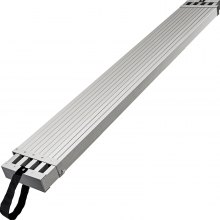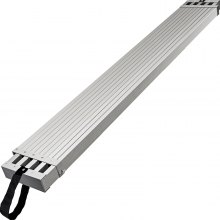VEVOR Examines Aluminum Scaffold Planks in Infrastructure Development
The role of scaffold planks in infrastructure building cannot be emphasized. Scaffold boards serve as temporary platforms for workers and materials at varying heights, forming the foundation of safe and efficient building operations.
Traditionally made of wood, these planks have seen a dramatic metamorphosis with the introduction of aluminum variations, which provide exceptional strength, durability, and adaptability.
Recognizing the critical significance of scaffold planks in building projects, VEVOR has begun on a path to evaluate and optimize the performance of aluminum scaffold planks, therefore significantly contributing to the improvement of infrastructure development methods throughout the world.
Uses Of Scaffold Planks
Scaffold planks are flexible equipment commonly used in building, remodeling, maintenance, and other industrial purposes. These solid wooden or metal platforms are crucial components of scaffolding systems, providing a secure working area for personnel at elevated heights.
However, scaffold planks are useful for much more than support since they are used in many industries.
Scaffolding Construction
Scaffold planks are typically used to create scaffolding systems, providing horizontal platforms for workers to stand, walk, or lay equipment and commodities. These planks provide a vital framework for securely and effectively reaching high-work sites.
Maintenance and Repair
Scaffold planks are essential for performing maintenance and repair activities in industrial facilities, commercial structures, and infrastructure projects. Scaffold planks offer workers a secure and sturdy platform to undertake vital maintenance operations such as repairing machinery and equipment and inspecting buildings and utilities.
Access Ramps and Bridges
Scaffold planks can be used to build temporary access ramps and bridges on construction sites, industrial facilities, and during outdoor events. These planks offer safe access over barriers, uneven terrain, and temporary gaps, allowing persons, equipment, and vehicles to travel seamlessly.
Scaffold planks provide temporary flooring and staging for events, exhibits, and outdoor gatherings. Scaffold planks are a low-cost and versatile alternative for producing elevated surfaces, whether they are used to build platforms for trade show booths, outdoor stages for concerts, or raised walkways for festivals.
Different Materials Of Scaffold Planks
Scaffold planks are available in various materials, each with unique properties appropriate to certain purposes and situations. Materials are chosen based on load capacity, durability, weather resistance, and affordability.
Wooden Scaffold Planks
Wooden scaffold planks are among the most classic and most used forms of scaffold planks. They are often built of high-quality hardwoods like pine, fir, or cedar, which are strong, durable, and resistant to warping and splintering.
Wooden scaffold planks are selected because of their inherent grip, making them ideal for damp or slippery environments. However, they require regular care, such as inspection, sanding, and sealing, to maintain their durability and safety.
Metal Scaffold Planks
Metal scaffold planks, commonly made of steel or aluminum, provide outstanding strength, durability, and load-bearing capability. Steel scaffold planks are known for their strength and resistance to large loads, making them ideal for high-traffic building sites and industrial applications.
Aluminum scaffold planks, on the other hand, are lightweight, corrosion-resistant, and suitable for projects that require easy handling and transportation. Metal scaffold planks are popular because of their durability and low maintenance needs, albeit they may be more expensive than wooden alternatives.
Composite Scaffold Planks
Composite scaffold planks are made from a combination of components, including wood fibers, plastic resin, and additives, to obtain desirable attributes, including strength, durability, and weather resistance.
These planks are a lightweight alternative to typical timber planks that provide increased durability, rot resistance, and reduced maintenance requirements.
Creative Use For Scaffolds Outside The Construction Industry
While scaffolds are most commonly associated with the construction sector, their usefulness goes beyond traditional uses. Creative minds have devised novel methods to recycle scaffolds in non-construction settings.
Here's a clever application for scaffolding outside of the building industry:
Stage Platforms
Scaffolds can serve as the basis for raised stages, giving artists a prominent platform to demonstrate their skills.
Organizers may build a strong and safe stage structure that can hold lighting, sound equipment, and performers of various weights by building scaffold frames and decking with durable scaffold boards.
Entrance Archways
Scaffolds may be utilized to create ornate entry archways that greet people and establish the tone for the event. Organizers may build visually appealing entry features by assembling scaffold frames in an arched shape and embellishing them with banners, lights, and flower arrangements.
Information Kiosks
Scaffolds may be converted into information kiosks or ticket booths, offering guests a single point of contact for event queries, ticket purchases, and product sales. By equipping scaffold structures with worktops, signs, and branding materials, organizers may create practical and branded kiosk areas that encourage visitor involvement and interaction.
Why Choose VEVOR?
VEVOR's scaffold planks stand out on the market for various compelling reasons, making them the preferred choice for professionals and organizations looking for dependable and high-quality scaffold solutions.
VEVOR scaffold planks are intended to meet various applications and project specifications. These planks are versatile and adaptable for various purposes, whether utilized in building, maintenance, industry, or events.
Safety is crucial on any job site, and VEVOR's scaffold planks are designed with this idea in mind. These planks have safety features, including non-slip surfaces, reinforced edges, and secure connection points to reduce the possibility of accidents and injuries. VEVOR also provides attachments like guardrails, toe boards, and safety harnesses to help improve workplace safety while utilizing scaffold planks. VEVOR scaffold planks are intended for simple installation and usage, allowing for a rapid and efficient setup on the job site.
FAQs About Scaffold Planks
What are the standard dimensions of scaffold planks?
Scaffold boards are commonly available in lengths ranging from 6 to 16 feet and widths ranging from 9 to 24 inches. Custom sizes may be available, depending on the manufacturer and the purpose.
Are scaffold planks reusable?
Yes, scaffold planks are normally intended to be reusable as long as they are properly maintained and examined for damage or wear. Regular care, such as cleaning, sanding, and sealing (for hardwood planks), can assist in extending their life and assure continuous safety and effectiveness.
How much weight can scaffold planks support?h3>
The weight capacity of scaffold boards varies according to their material, size, and design. In general, scaffold planks are intended to sustain the weight of personnel, tools, and materials in accordance with industry norms and regulations. Load capacities normally vary between 250 and 750 pounds per plank, but heavier-duty variants are available for particular applications.

























































































